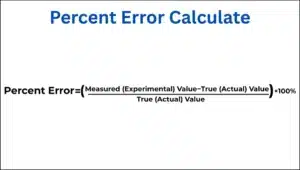Percent Error Calculator
Calculate the Percent Error between Experimental and Theoretical values.
Percent error is a useful measure that tells us how accurate a measured or estimated value is compared to the true or accepted value. It expresses the error as a percentage relative to the actual value, allowing easy interpretation of the level of accuracy or deviation.
What is the Percent Error Calculator?
Percent error quantifies the difference between an estimated or measured value and the true value, expressed as a percentage of the true value. It helps highlight how large the error is in relation to the accepted value. A smaller percent error means the estimate is closer to the true value, while a larger percent error indicates a bigger deviation.

Why a Percent Error Calculator
Percent error is frequently used in scientific experiments, engineering, and mathematics to:
- Assess measurement accuracy
- Compare estimated results with actual values
- Understand limitations due to human error or instrument precision
- Improve experimental methods or calculations
The Percent Error Formula
The formula to calculate percent error is:Percent Error=∣Measured Value−True Value∣×100%Percent Error=True ValueMeasured Value−True Value×100%

Key points:
- Use the absolute value (ignoring any negative sign) so the error is always expressed as a positive percentage.
- The “Measured Value” is the value obtained from your experiment, estimation, or calculation.
- The “True Value” is the exact, accepted, or theoretical value that you compare against.
Step-by-Step Calculation of Percent Error
- Identify the true (accepted) value and the measured (experimental) value.
- Find the difference between the measured and true values: Error=Measured Value−True ValueError=Measured Value−True Value
- Take the absolute value of this difference :Absolute Error=∣Error∣Absolute Error=∣Error∣
- Divide the absolute error by the true value: Relative Error=Absolute ErrorTrue ValueRelative Error=True Absolute Error
- Multiply by 100 to convert to a percentage:Percent Error=Relative Error×100%Percent Error=Relative Error×100%
Example Calculation
Suppose you measure the length of a rope and find it to be 48 cm. The actual length is 50 cm. What is the percent error?
- Measured Value = 48 cm
- True Value = 50 cm
Steps:
- Calculate the difference: 48−50=−248−50=−2
- Take absolute value: ∣−2∣=2∣−2∣=2
- Divide by true value: 250=0.04502=0.04
- Convert to percentage: 0.04×100=4%0.04×100=4%
So, the percent error is 4%, indicating your measurement is very close to the actual length.
Our More Tools
Summary
- Percent error provides a standardized way to communicate the accuracy of measurements.
- Always base the calculation on the true value to gauge how much your estimate deviates.
- Use absolute values so the sign of the difference doesn’t affect the error magnitude.
- Multiply by 100 to express the error as a percentage for easy understanding.
By following these steps and using the formula, you can calculate percent error accurately to assess and improve your measurements and experiments.
